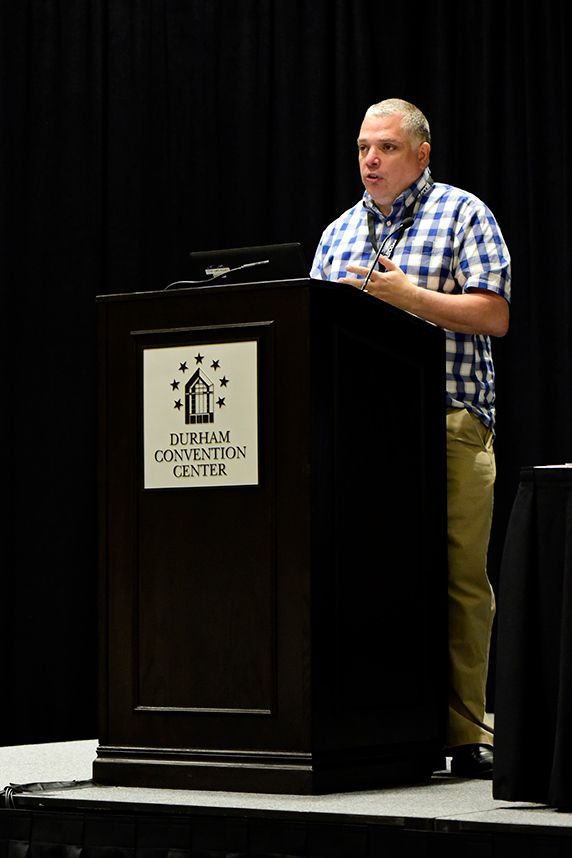A widespread group of man-made chemicals — some of which can cause harmful effects in humans and the environment — was the focus of a scientific conference held in Durham, North Carolina, August 12–15. The North American division of the Society of Environmental Toxicology and Chemistry (SETAC) hosted the meeting, titled “Environmental Risk Assessment of Per- and Polyfluoroalkyl Substances (PFAS).”
“Why are we concerned about PFAS? Not only because of their tremendous presence in the environment but also because they are a multisystem toxicant,” said NIEHS and National Toxicology Program (NTP) Director Linda Birnbaum, Ph.D., during her keynote address.
 “PFAS are being called ‘forever chemicals,’ and that is because their carbon-fluorine bond is one of the strongest bonds that exists,” said Birnbaum. “It’s not a very common bond in nature, and we do not have many microbial ways to break it down.” (Photo courtesy of Steve McCaw)
“PFAS are being called ‘forever chemicals,’ and that is because their carbon-fluorine bond is one of the strongest bonds that exists,” said Birnbaum. “It’s not a very common bond in nature, and we do not have many microbial ways to break it down.” (Photo courtesy of Steve McCaw)“There is growing evidence from multiple studies … about the impacts of different PFAS on the thyroid, the immune system, the liver, the pancreas, the kidney, [and] the reproductive organs,” she said. “And one of my biggest concerns is the neurodevelopmental effects.” She added that in the U.S., one-third of the population is exposed to elevated PFAS levels in drinking water.
PFAS are in hundreds of industrial and consumer products, such as firefighting foam and nonstick cookware. Their chemical makeup is such that they can remain in the environment and human body for long periods. And in addition to the health problems referenced by Birnbaum, animal studies have linked some PFAS to low birth weight and cancer.
New approaches needed
The fact that there are more than 4,700 PFAS complicates matters for researchers. A one-size-fits-all approach to understanding them will not work. SETAC’s goal for the conference was to help scientists studying these chemicals share their latest findings, identify information gaps, ponder future research projects, and discuss new approaches to determining risk from PFAS.
Major themes were chemistry, environmental exposure, human toxicology, ecotoxicology, and risk characterization. In roughly 40 presentations, scientists discussed topics such as the following:
- Methods for detection and measurement.
- Dietary exposure.
- Drinking water systems.
- Reproductive and developmental toxicity.
- Effects on animals.
 DeVito explained the research approaches NTP is using to better understand PFAS. (Photo courtesy of Steve McCaw)
DeVito explained the research approaches NTP is using to better understand PFAS. (Photo courtesy of Steve McCaw)On the second day of the conference, Mike DeVito, Ph.D., head of the NTP Laboratory, explained some of the factors that can make PFAS research difficult. For example, the class includes many different chemical structures, and exposure can occur orally but also through inhalation and skin contact.
“We have a lot of challenges that are not going to be solved in our traditional methods,” he told the audience.
To overcome some of those research challenges, NTP analyzes large data sets involving different PFAS, conducts in-depth reviews of previously published research, and collaborates with other experts in the field.
DeVito said that among their other projects, NTP toxicologists are working to determine whether immune system effects caused by some PFAS also are caused by other chemicals in the class.
Well-timed studies
NIEHS also is working to increase understanding of PFAS. It conducts in-house research and funds important initiatives at universities across the country, including timely studies in the aftermath of PFAS-related public health crises, Birnbaum explained.
 The SETAC meeting was held at the Durham Convention Center. (Photo courtesy of Steve McCaw)
The SETAC meeting was held at the Durham Convention Center. (Photo courtesy of Steve McCaw)For example, in 2017, the Cape Fear River, which is the water source for Wilmington, North Carolina, was found to be contaminated with GenX, a type of PFAS. Soon after, the institute provided a grant to collaborators from North Carolina State University and East Carolina University to study the effects.
“We are probably the largest funder of human health effects of PFAS,” Birnbaum noted. Each year, NIEHS provides between roughly $10 million and $12 million for outside research on the topic.
(Jesse Saffron, J.D., is a technical writer-editor in the NIEHS Office of Communications and Public Liaison.)









